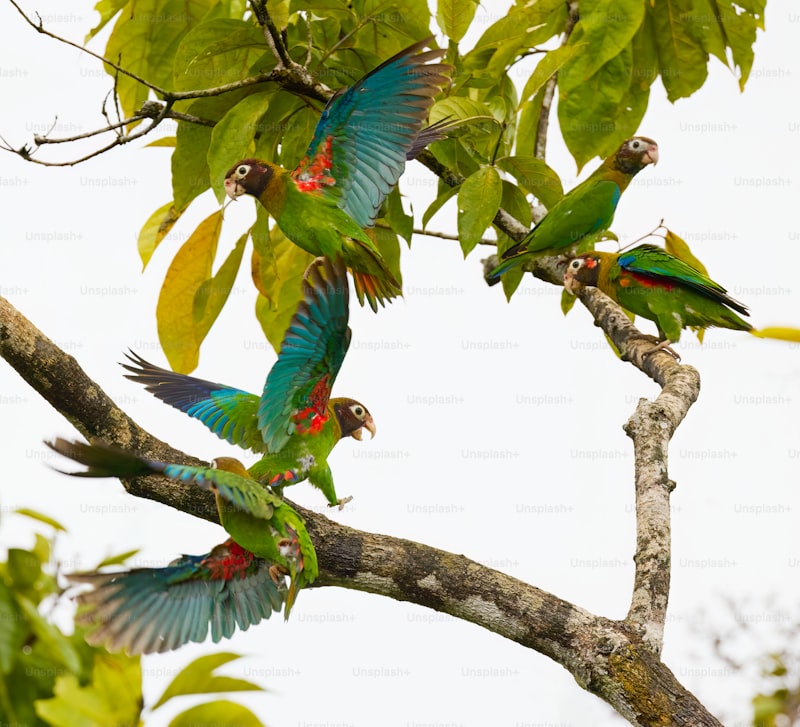First things first, before you begin any training sessions, ensure your parrot feels comfortable and safe in its environment. Parrots thrive in stable, secure surroundings, so make sure their cage is spacious, well-equipped with toys, perches, and fresh water. A happy parrot is more likely to engage and learn from you.
The cornerstone of parrot training is positive reinforcement. Parrots, like humans, respond best to praise and rewards. When your parrot exhibits the behavior you desire, such as stepping onto your hand or saying a word, immediately reward them with a treat they love, like a small piece of fruit or a nut. This reinforcement solidifies the connection between the action and the reward, making your parrot eager to repeat the behavior.
Consistency is key. Set aside short but regular training sessions, preferably at the same time each day. Parrots are creatures of habit and thrive on routine. Keep the sessions fun and engaging, no longer than 10-15 minutes at a time to maintain your parrot’s interest and prevent frustration.
Start with basic commands or tricks. Teach your parrot to step onto your hand or a perch on cue. Use a verbal command paired with a gesture to help them understand what you want them to do. For example, say “Step up” while offering your hand, and reward them when they comply. Repeat this consistently until they start associating the command with the action.
Patience is crucial in parrot training. Some birds may pick up new behaviors quickly, while others may take more time. Every parrot is unique, so adjust your training pace accordingly. Remember, training should always be a positive experience for both you and your parrot.
Incorporate play into your training sessions. Parrots are intelligent and curious creatures who love to explore and interact with their surroundings. Use toys and games to keep them engaged and motivated during training.
By following these steps and being patient and consistent, you’ll be well on your way to having a well-trained and happy parrot companion. Enjoy the journey of discovery and learning together with your feathered friend!
Mastering Mimicry: Teaching Your Parrot to Speak in 5 Simple Steps
-
Choose Your Words Wisely: Start with simple, clear words or phrases that are easy for your parrot to mimic. “Hello”, “Good morning”, or even its own name are excellent starting points. Repeat these words consistently in a calm and encouraging tone.
-
Create a Learning Environment: Parrots learn best in a calm and quiet environment free from distractions. Choose a time of day when your parrot is most alert and receptive, typically in the morning or early evening.
-
Repetition is Key: Consistency is crucial in teaching your parrot to speak. Repeat the chosen words or phrases frequently throughout the day, reinforcing positive behavior with treats or praise when your parrot attempts to mimic you.
-
Use Mimicry Games: Engage your parrot in mimicry games to encourage vocalization. Repeat phrases back to your parrot and wait for it to respond. Reward even small attempts at speech with enthusiasm and treats.
-
Patience and Persistence: Teaching your parrot to talk takes time, sometimes weeks or months. Be patient and persistent in your efforts, adjusting your approach based on your parrot’s progress and personality.
By following these five steps consistently and with patience, you can nurture your parrot’s ability to mimic speech effectively. Remember, each parrot learns at its own pace, so celebrate every milestone, no matter how small, in this delightful journey of mastering mimicry.
Bonding Beyond Words: Building Trust with Your Parrot Through Training
Training your parrot is not just about teaching tricks; it’s a pathway to mutual respect and bonding. Imagine your parrot perched on your shoulder, eagerly awaiting the next training session as a time of joy and connection. Through positive reinforcement and patience, you can build trust step by step.
Start with simple commands like “step up” or “wave hello,” using treats as rewards. This creates a positive association between training and pleasure, making your parrot eager to learn. Remember, consistency is key; regular, short sessions yield better results than sporadic long ones.
As your parrot learns, observe its body language and responses. Each interaction deepens your understanding of its personality and preferences. Like nurturing a friendship, training requires empathy and adaptability. Just as humans build trust through shared experiences, so too can you and your parrot through meaningful interactions.
Training sessions are opportunities for bonding beyond words. They’re moments where you learn to anticipate each other’s needs and desires, strengthening the bond. It’s akin to dancing together in harmony, where every move is a step towards greater mutual understanding.
Training your parrot isn’t just about teaching skills; it’s about building a relationship based on trust and respect. Through consistent training and positive reinforcement, you create a partnership that transcends verbal communication, enriching both your lives. So, embrace the journey of bonding with your parrot—it’s a journey of love, patience, and profound connection.
Feathered Brilliance Unveiled: The Science Behind Parrot Learning
Have you ever marveled at the astounding intelligence of parrots? These vibrant birds are not just a feast for the eyes with their kaleidoscopic plumage; they are also remarkable learners in the avian world. Understanding the science behind parrot learning unveils a world of cognitive prowess and adaptability.
Parrots, renowned for their colorful feathers and ability to mimic human speech, showcase an intricate cognitive ability that rivals some primates. Their learning capabilities are rooted in a complex brain structure that supports advanced problem-solving and social interaction. Similar to humans, parrots possess a highly developed forebrain, enabling them to process information swiftly and engage in sophisticated behaviors.
One of the most fascinating aspects of parrot learning is their adeptness at vocal mimicry. This ability is not merely about copying sounds but involves understanding and reproducing complex sequences. Parrots can mimic not only human speech but also a wide array of environmental sounds, demonstrating a flexibility in vocal learning unparalleled in the avian world.
Moreover, parrots exhibit social learning behaviors akin to humans and certain primates. They learn by observing others, both within their species and outside it, adapting behaviors that prove advantageous in their environment. This social learning extends beyond vocalizations to include problem-solving techniques, feeding behaviors, and even cultural traditions within parrot communities.
In captivity, parrots continue to fascinate researchers with their ability to learn new skills and behaviors from their human companions. This interaction highlights their adaptive intelligence and the mutual learning that occurs between parrots and humans.

Understanding the science behind parrot learning not only enriches our appreciation for these magnificent birds but also provides insights into animal cognition and intelligence. It underscores the importance of cognitive enrichment and social interaction in maintaining the well-being of parrots both in the wild and in captivity.
Exploring the intricacies of parrot learning reveals a world where brilliance meets adaptability, offering a deeper understanding of these feathered wonders.
From Squawk to Serenade: Training Your Parrot to Sing Melodies
Firstly, choose the right environment for training sessions. Select a quiet space free from distractions where your parrot feels comfortable and safe. A relaxed bird is more receptive to learning new sounds. Start with short sessions, as parrots have short attention spans. Begin by whistling or singing simple melodies yourself. Parrots are excellent imitators and will often try to mimic sounds they hear regularly.
Use positive reinforcement techniques such as treats or praise when your parrot attempts to mimic a melody. Rewarding even small attempts encourages them to continue trying. Repetition is key; practice the same melody consistently during sessions to help your parrot grasp the tune. Break down complex melodies into smaller segments to make learning easier.
Engage your parrot’s curiosity by varying the melodies you teach. Some parrots prefer certain types of music over others, so experiment with different genres to see what captures their interest. Incorporate musical instruments or recordings of songs to provide variety and stimulate their learning.
Remember, each parrot learns at its own pace. Be patient and celebrate each step of progress, whether it’s a new note or a clearer rendition of a melody. Building a strong bond with your parrot through music strengthens your relationship and enhances their mental stimulation.
Navigating Temperament: Tailoring Training Techniques for Different Parrot Personalities
Training a parrot can be as diverse as the birds themselves. Just like people, parrots have unique personalities that influence how they respond to training. Understanding these personalities is key to successful training sessions that are both effective and enjoyable for both bird and owner.
Firstly, parrots can be broadly categorized into different personality types. Some are outgoing and eager to learn new tricks, while others may be more reserved or cautious. This diversity means that a one-size-fits-all approach to training simply won’t work. Instead, trainers need to adapt their methods to suit each bird’s individual temperament.
For outgoing parrots, training can be a lively and engaging experience. These birds thrive on social interaction and may quickly pick up new behaviors when rewarded with praise or treats. Using positive reinforcement techniques such as clicker training can be highly effective, as it provides instant feedback and encourages the bird to repeat desirable behaviors.
On the other hand, more reserved parrots may require a gentler approach. Patience is key when working with these birds, as they may take longer to trust their trainer and feel comfortable trying new things. Starting with basic commands and gradually building confidence through small, achievable steps can help these birds develop their skills without feeling overwhelmed.
Understanding each parrot’s unique preferences is also crucial. Some birds may be motivated by food rewards, while others respond better to verbal praise or interactive play. By observing their reactions and adjusting training methods accordingly, trainers can build trust and strengthen the bond between bird and human.
Flying High: Teaching Advanced Tricks to Your Parrot with Patience and Perseverance

Firstly, let’s talk about the importance of patience. Just like humans, parrots have their own pace of learning. They might not get it right the first time, or even the tenth time! But patience means understanding that each attempt is a step closer to success. Imagine teaching a child to ride a bicycle; you wouldn’t expect them to balance perfectly on their first try, would you? The same principle applies here.
Perseverance is equally vital. It’s about staying committed to the process even when it feels like progress is slow. Consistency is key. Repeat the training sessions regularly, but keep them short and engaging. Parrots, like us, thrive on routine and positive reinforcement. When they see that their efforts are met with praise and maybe even a tasty treat, they’ll be motivated to keep trying.
Now, let’s dive into the actual tricks. Advanced tricks go beyond the basics like stepping up or mimicking sounds. They can include complex behaviors like fetching objects, sorting colors, or even solving puzzles. Each trick builds on foundational skills, so it’s essential to start with simpler tasks before progressing to more challenging ones.
For instance, teaching your parrot to fetch objects can be a fun challenge. Begin by associating a specific object with a reward, such as a small piece of fruit or a nut. Use positive reinforcement each time your parrot interacts with the object, gradually shaping the behavior until they reliably pick it up and bring it to you. It’s like teaching them a game where everyone wins!
Remember, every parrot is unique. Some may take to tricks quickly, while others might need more time to grasp the concept. Celebrate small victories along the way and adjust your approach based on your parrot’s responses. With patience, perseverance, and a sprinkle of creativity, you’ll soon find yourself amazed at what your feathered friend can achieve!
Frequently Asked Questions
What are effective methods for teaching tricks to my parrot
Discover effective methods for teaching tricks to your parrot with our concise FAQ. Learn step-by-step techniques to engage your bird, build trust, and reinforce behaviors. Whether you’re starting with simple commands or advancing to complex tricks, our guide ensures fun and successful training sessions.
What are the first steps to training a parrot
Learn the essential first steps to training your parrot with our concise guide. Discover how to establish trust, begin basic commands, and create a positive learning environment. Start your parrot’s training journey confidently with expert tips and proven techniques.
How do I teach my parrot to talk
Learn effective methods to teach your parrot to talk with patience and consistent training. Start by choosing simple, clear words and phrases, and repeat them regularly in a calm environment. Use positive reinforcement like treats and praise when your parrot mimics sounds or words. Gradually increase difficulty and practice daily for best results.
How can I potty train my parrot
Discover effective methods for potty training your parrot with our concise guide. Learn step-by-step techniques to teach your bird where and when to relieve itself, ensuring a cleaner and happier environment for both you and your feathered friend.
How do I deal with behavioral issues during training
Learn effective strategies for handling behavioral issues during training sessions with clear communication, positive reinforcement, and consistent expectations. Address challenges promptly while reinforcing desired behaviors to create a productive learning environment.


